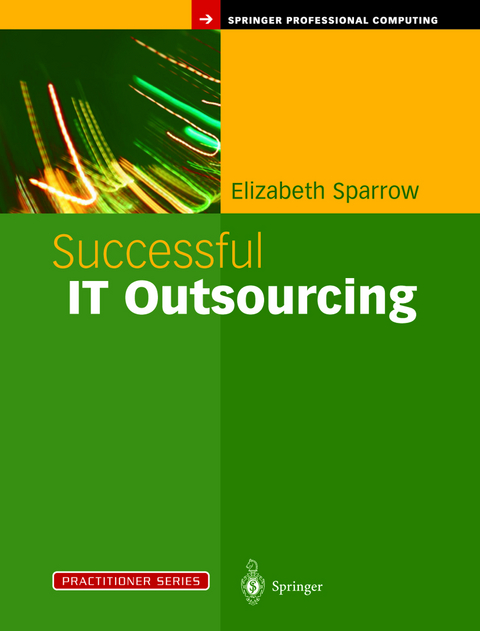
Successful IT Outsourcing
Springer London Ltd (Verlag)
978-1-85233-610-3 (ISBN)
Outsourcing permeates the IT world and has had a profound impact on the work of IS professionals. Nearly all will, at some stage in their careers, work with outsourced services as customer or supplier. Elizabeth Sparrow's insights into the benefits and pitfalls of this complex area will help IS professionals tackle the challenges of outsourcing. Combining relevant background information with practical guidance this book covers the whole outsourcing process, from the initial decision to outsource through to managing the outsourced services on a day-to-day basis.
Successful IT Outsourcing considers:
- The objectives behind outsourcing
- The selection of a service provider
- The management and measurement of the performance of outsourced services
- The role of the outsourcing contract
- Why outsourcing sometimes fails and how to turn failure into success
Features and Benefits:
- Describes the origins of IT outsourcing, and recent developments
- Examines the way in which an organization might determine whether to outsource and how it can choose a service provider
- Discusses how to develop effective outsourcing relationships
- Provides context and advice to assist IS professionals, whose work is being outsourced, as they consider their future careers and the possibility of transferring to a new employer
1. Introduction to IT Outsourcing.- 1.1 What Is IT Outsourcing?.- 1.2 History of IT Outsourcing.- 1.3 Size and Scope of the IT Outsourcing Market.- 1.4 Different Sourcing Models.- 2. The Case For and Against Outsourcing.- 2.1 Introduction.- 2.2 Arguments in Favour of Outsourcing.- 2.3 Arguments Against Outsourcing.- 2.4 If Your Department Is to Be Outsourced.- 3. Objectives and Parameters for Outsourced Services.- 3.1 Introduction.- 3.2 The Importance of Objectives.- 3.3 Understanding Stakeholders’ Objectives.- 3.4 Analysing Objectives.- 3.5 Selecting Outsourcing Candidates.- 3.6 Benchmarking.- 3.7 In-house Improvements.- 3.8 Defining Service Requirements.- 3.9 Business Case Analysis.- 3.10 StaffTransfers.- 3.11 Outsourcing Programme Management.- 4. Choosing a Service Provider.- 4.1 Introduction.- 4.2 Managing the Selection Process.- 4.3 Investigating the Computer Services Market.- 4.4 Evaluation.- 4.5 Short-listing Potential Suppliers.- 4.6 Selecting the Preferred Bidder.- 4.7 Negotiations.- 4.8 Contract Award.- 4.9 The Importance of the Relationship Between Customer and Supplier.- 5. Managing Performance.- 5.1 Introduction.- 5.2 Building Outsourcing Relationships.- 5.3 Understanding Stakeholder Perspectives.- 5.4 Outsourcing “Partnerships”.- 5.5 Communicate, Communicate, Communicate.- 5.6 Transition.- 5.7 Incentives and Disincentives.- 5.8 Adding Value.- 5.9 Contract Management.- 5.10 Service Management.- 5.11 Service Users.- 5.12 Contract Administration.- 5.13 Outsourcing Management Organization.- 5.14 Meetings.- 5.15 Change Control.- 5.16 Issue Management and Problem Escalation.- 5.17 Critical Success Factors.- 6. Measuring Performance.- 6.1 Introduction.- 6.2 Linking Performance Measures to Objectives.- 6.3 Setting a Baseline.- 6.4 Benchmarking.- 6.5Measuring Benefits.- 6.6 Involving Service Users.- 6.7 Service Level Management.- 6.8 Service Level Agreements.- 6.9 Managing Multiple Suppliers.- 7. Risks and Controls.- 7.1 Introduction.- 7.2 Outsourcing Contracts.- 7.3 Outsourcing Risks.- 8. When Outsourcing Fails to Deliver.- 8.1 Introduction.- 8.2 Reasons Why Outsourcing Fails.- 8.3 Warning Signals.- 8.4 Challenging Failure.- 8.5 Formal Action Against Your Supplier.- 8.6 Backsourcing.- 9. ASPs, WASPs and the Future of Outsourcing.- 9.1 Alternative Supply Models.- 9.2 Other Outsourcing Trends.- 9.3 The Impact of Outsourcing on the IT Department.- 9.4 Conclusion.- Useful Websites.
From the reviews:
The book is a step-by-step guide to the process of IT outsourcing. It assumes a standing start, so the history lesson comes first. For example, EDS was doing it 40 years ago. There is a thoughtful debate on the arguments for and against outsourcing before a study of the objectives and how to find and measure your service provider.The main strength of this book is the quality of the case studies and examples. The author comments on real-life situations and creates a sense of inclusion. She has clearly seen many technology projects outsourced in various ways and her comments are from the real world of IT management, not an ivy-clad business school.This is a very useful book for any manager thinking about outsourcing or anyone who wants to improve an existing relationship. The comments on project risk and delivery failures are direct, and ensure the book does not sell outsourcing as a panacea for broken systems. It is an authoritative guide to the process of IT outsourcing and I strongly recommend it.
Mark Kobayashi-Hillary MBCS - 'Computer Bulletin', May 2004 (Book of the month)
---------
The growing tendency to outsource IT work has profoundly affected the careers of information professionals: Nearly all of them will, at some stage, work with outsourced services as a customer or supplier. The author’s insights into the benefits and pitfalls of this complex area can help these professionals tackle outsourcing’s challenges.
This book covers the outsourcing process from the initial decision to outsource through daily management of outsourced services. It considers the objectives behind outsourcing, selection of a service provider, management and measurement of the outsourced services’ performance, the outsourcing contract’s role, why outsourcing sometimes fails, and how to turn failure into success.
The author describes the origins ofIT outsourcing and recent developments and also offers advice to information professionals who suddenly find their jobs being outsourced.
‘Computer’, December 2003
"The title of the book is a bold promise to the reader, and it does not disappoint. The book is a step-by-step guide to the process of IT outsourcing. … The main strength of this book is the quality of the case studies and examples. … This is a very useful book for any manager thinking about outsourcing or anyone who wants to improve an existing relationship. … an authoritative guide to the process of IT outsourcing and I strongly recommend it." (Computer Bulletin, May, 2004)
| Erscheint lt. Verlag | 17.6.2003 |
|---|---|
| Reihe/Serie | Practitioner Series |
| Zusatzinfo | XV, 272 p. |
| Verlagsort | England |
| Sprache | englisch |
| Maße | 178 x 254 mm |
| Themenwelt | Sachbuch/Ratgeber ► Beruf / Finanzen / Recht / Wirtschaft ► Bewerbung / Karriere |
| Informatik ► Software Entwicklung ► User Interfaces (HCI) | |
| Mathematik / Informatik ► Mathematik ► Finanz- / Wirtschaftsmathematik | |
| Wirtschaft ► Betriebswirtschaft / Management ► Logistik / Produktion | |
| Wirtschaft ► Betriebswirtschaft / Management ► Unternehmensführung / Management | |
| ISBN-10 | 1-85233-610-2 / 1852336102 |
| ISBN-13 | 978-1-85233-610-3 / 9781852336103 |
| Zustand | Neuware |
| Haben Sie eine Frage zum Produkt? |
aus dem Bereich


